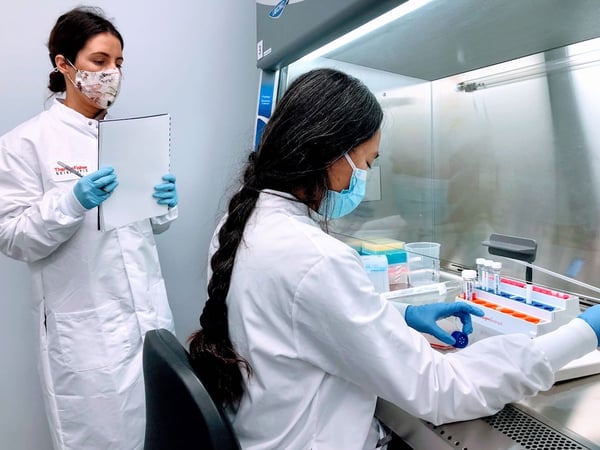Read on to discover what happens after a company is accepted into a wet lab incubator.
Every wet lab incubator is different, but there are some aspects of life within that are common across most such facilities. For startups who are considering applying to wet lab incubators, it can be helpful to understand what day-to-day life is like so they can decide whether it fits their company’s culture.
🔬 Read more about: Lab Space for Biotech Startups.
After being accepted into a wet lab incubator, new members generally must sign an agreement of some kind. This may be a service agreement, membership agreement, or a lease. Such agreements usually include the terms of use for the space, limits on the incubator’s liability, the amount of notice each party must provide in order to not renew the agreement, and the basic rules for conduct within the space. Once this is signed, most incubators will require at least the first month’s fees to be paid prior to move-in, and some require a deposit as well.
Once the agreement is signed and the initial fees paid, onboarding of the new member can begin. This will usually require the startup to provide the names and contact information of all employees who will be accessing the space on a regular basis. The incubator usually provides additional documentation at this point that pertains to safety, policies, and conduct. Safety documentation may include a safety manual and/or links to safety courses. Incubators’ policies commonly include the approved methods for purchasing, booking equipment, storing property, and reporting issues. Conduct refers to the behavior of a member company’s employees, which is particularly important in a shared space. Employees may be required to sign that they have read and understood the documentation provided by the incubator.
When onboarding is complete, the next step is for the company to move their property to the incubator. Most incubators prefer this to be scheduled ahead of time so they can have any keys or key cards/fobs ready for the new member. Incubators generally do not provide moving assistance as a service, so new member companies either have to move their property into the incubator themselves or hire an outside moving company. If the member is not moving large equipment into the space, usually a moving company is unnecessary. However, startups should be aware that if they do hire a moving company many will not touch lab equipment or chemicals, in which case the member may need to hire a moving company that specializes in labs.
Common problems for companies to experience during move in are usually related to either the size of the equipment they are bringing in, or its electrical requirements. Even if an incubator does not ask about this during onboarding, it is a good idea for the startup to ask what the size, weight, and electrical limits are for items they bring in.
Some incubators are very hands-off during the move-in and do not make a big deal of it. Others celebrate new company move-ins, make introductions to the other members, or otherwise recognize the event.

Wet lab incubators tend to be relatively quiet spaces to work in most of the time. This is due in part to members requiring both lab and desk space, so if they are in the lab, their desk will be empty. It is also because scientists and engineers often work different hours than the standard 9 to 5. Some arrive at 6am and leave at 2pm, while others arrive at noon and leave at 8pm. Here are 8 things that an incubator member may do or utilize on a normal day at a wet lab incubator.
Depending on the services offered by the incubator, a normal day might begin with members arriving throughout the morning, finding fresh coffee in the kitchen and stacks of deliveries next to their offices/desks/labs. As they work, they may see incubator staff conducting tours for prospective members, showing equipment maintenance technicians to the right location, or discussing discounted pricing with vendors.
In the lab, members might book certain types of equipment using online calendars, and other equipment they might use on first-come, first-served basis. In an incubator with a collaborative atmosphere, companies may communicate with each other regularly to coordinate equipment use. For example, if multiple companies need to use a bacterial shaker but at different temperatures, they might negotiate who will use it on which days.
Another lab-related task that can be unique to incubators is the process for purchasing hazardous chemicals. Since incubators have to consider the total volume of chemicals and monitor the types of hazards present, many spaces will have systems for purchasing them. This may be in the form of an approval process or the incubator might purchase the items and charge the member afterward. Though it might seem cumbersome, by monitoring hazardous chemical purchases the incubator is able to report these to regulatory agencies rather than each member having that burden. Plus, the incubator can alert members to any new hazards, or prevent hazards that are too dangerous from being brought on site.
When chemicals or any other packages are received at an incubator, the staff generally will sort out what belongs to each member and either bring it to them directly or alert them that the item has arrived. In some cases, incubator staff will even unpack and store perishable items for their members.
Many startups have weekly meetings in order to update the team on progress. At an incubator these meetings are usually held in a conference room and booked either online or by notifying incubator staff. The availability of audio-visual equipment will vary.
Some wet lab incubators hold events in their space which members are invited to attend. These may be lunch-and-learns, scientific seminars, networking events, or workshops, to name a few. Most incubators that do hold events try to limit potential disruptions to members who are not participating.
Another resource that some incubators incorporate is “office hours” from vetted service providers. This is when an IP attorney, for example, will come to the incubator at a scheduled time each week and meet with any members who are interested. Thus, members of the incubator can receive free services—or at least try out the service briefly before deciding to sign a contract with them.
Lastly, a normal day at an incubator hopefully will include positive interactions with incubator staff. These people are interested in the wellbeing of their members and appreciate hearing about their successes. Incubator staff are not only indispensable for helping with technical and business issues, but also for offering support and encouragement to their members.
🔬 Learn about: How Coworking Spaces are Helping the Startup Culture Thrive

One important factor to remember about incubators is that each day is unlikely to be exactly the same as the one before. That said, there is a normal range of activities and occurrences that can be expected with some frequency. Outliers will exist, and there are a few that can be expected though with low frequency. Here are 4 abnormal occurrences that might make that day at the incubator less than stellar.
Equipment can malfunction or break even if it is brand-new. Unfortunately, nothing is made to last forever, so issues can be expected to happen once in a while. In an incubator this can unfortunately affect many members and slow their progress. However, sometimes a piece of shared equipment can go down but another member might own a similar piece and be willing to allow others to use it. Or, in the reverse circumstance, a member might own a piece of equipment for their exclusive use, but if it malfunctions the incubator might have one in their shared equipment inventory.
One big step up on the scale of problems that can happen in a wet lab is a power outage or other issue that affects the entire space. Most incubators have backup power systems for freezers and incubators, but it’s rare to see all lab and office equipment on backup. Therefore, these types of issues will tend to disrupt everyone’s work. Incubator staff will work to get the problem resolved on behalf of all members.
While ideally not a problem at all, regulatory inspections are another potential occurrence in any laboratory that can affect an incubator’s day-to-day functions. Some inspections are announced ahead of time, allowing both members and incubator staff to prepare. Others, however, are surprise inspections. Most regulatory professionals will not interrupt ongoing work during an inspection, but if they find a problem that can cause issues. Luckily many incubators have safety programs that help all members keep their spaces up to code, so inspections are not a cause for concern.
Smaller events might happen on a regular day at an incubator, but some places also hold large events, though infrequently. These are usually announced well ahead of time if they will potentially disrupt the working environment. On the positive side, the event might be a good networking opportunity for members. On the negative side, it could cause noise or distraction that make working during the event difficult.
Although wet lab incubators are wonderful places for young companies to get their start, eventually those companies will outgrow the space. Whether because they need to hire more employees, buy more equipment, or move into more highly regulated space, it is expected that members will leave the incubator as they grow.
The timeline for moving out of an incubator, or “graduating,” as some call it, vary from space to space. Because most companies that use wet lab space are in highly regulated industries, they usually need more time than other types of companies to get to the next phase of their development. Generally, though, wet lab incubators expect their companies to graduate within 1-3 years. Some incubators also evaluate milestone achievement.
When a member company is planning to move out, the incubator may be highly involved in the process or may be hands-off. A highly involved incubator might be able to make connections between the member company and real estate brokers or directly with building owners to assist the member in finding new lab space. They may also introduce the members to lab equipment and furniture vendors as needed. Regardless of the level of involvement, all incubators will require certain processes be followed in preparation for leaving. This usually includes planning the best routes for movers to get through the space without disrupting other companies, the time and day of the move itself, where boxes might be staged beforehand, and other such logistics. After the member’s property has been removed from the space, the incubator will inspect the space for signs of damage, collect keys/key cards, and possibly have a celebration to say goodbye to a part of their community.
Life at a wet lab incubator isn’t for every company, but it does confer a sense of community and provide resources that many startups would not otherwise be able to access. Even something as simple as being able to ask a neighboring startup to borrow a reagent can be a valuable part of the experience. Read this post to learn about wet lab incubators in Southern California.
🔬 Related: What is a Wet Lab Incubator?
Download The Ultimate Guide to Wet Lab Incubators in Southern California, a handbook to assist life science start-ups through the entire decision-making process to find wet lab space.
Download Now